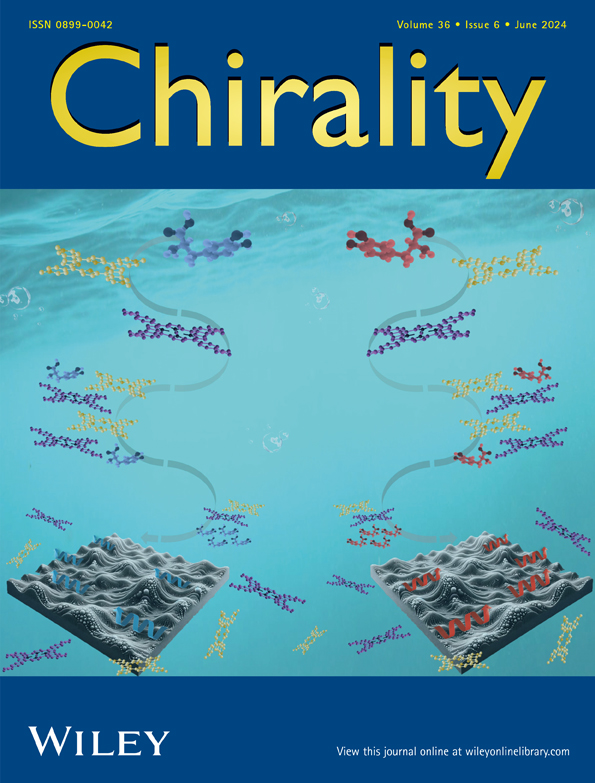Counting the truxillines—11 or more, the question is now
Corresponding Author
Tomislav Portada
Laboratory for the Computational Design and Synthesis of Functional Materials, Division of Organic Chemistry and Biochemistry, Ruđer Bošković Institute, Zagreb, Croatia
Correspondence
Tomislav Portada, Laboratory for the Computational Design and Synthesis of Functional Materials, Division of Organic Chemistry and Biochemistry, Ruđer Bošković Institute, Bijenička cesta 54, 10000 Zagreb, Croatia.
Email: [email protected]
Contribution: Conceptualization, Writing - original draft, Supervision, Investigation, Visualization
Search for more papers by this authorZlatko Brkljača
Division of Organic Chemistry and Biochemistry, Ruđer Bošković Institute, Zagreb, Croatia
Selvita d. o. o., Zagreb, Croatia
Contribution: Investigation, Visualization
Search for more papers by this authorCorresponding Author
Tomislav Portada
Laboratory for the Computational Design and Synthesis of Functional Materials, Division of Organic Chemistry and Biochemistry, Ruđer Bošković Institute, Zagreb, Croatia
Correspondence
Tomislav Portada, Laboratory for the Computational Design and Synthesis of Functional Materials, Division of Organic Chemistry and Biochemistry, Ruđer Bošković Institute, Bijenička cesta 54, 10000 Zagreb, Croatia.
Email: [email protected]
Contribution: Conceptualization, Writing - original draft, Supervision, Investigation, Visualization
Search for more papers by this authorZlatko Brkljača
Division of Organic Chemistry and Biochemistry, Ruđer Bošković Institute, Zagreb, Croatia
Selvita d. o. o., Zagreb, Croatia
Contribution: Investigation, Visualization
Search for more papers by this authorAbstract
Truxillines are a group of tropane alkaloids present in coca leaves that are formed by photochemical dimerization of cinnamoylcocaine(s). Proportion of different truxilline forms present in cocaine serves as its geographical, manufacture, and storage “fingerprint”; thus, the quantitative determination of truxilline content represents one of the powerful methods of analysis and characterization of cocaine samples. Contrary to the statements repeatedly presented in the literature, namely, that there exist exactly 11 truxillines and that every single truxilline is diastereomer of any other, here we show that, in fact, a total of 15 truxillines exist, which can be divided in two structurally isomeric groups—five mutually diastereomeric truxillates and 10 mutually diastereomeric truxinates.
Open Research
DATA AVAILABILITY STATEMENT
Data sharing is not applicable to this article as no datasets were generated.
REFERENCES
- 1Novák M, Salemink CA, Khan I. Biological activity of the alkaloids of Erythroxylum coca and Erythroxylum novogranatense. J Ethnopharmacol. 1984; 10(3): 261-274. doi:10.1016/0378-8741(84)90015-1
- 2Fodor G. Chapter 8—tropane alkaloids. Alkaloids: Chem Physiol. 1997; 13: 251-276. doi:10.1016/B978-044453347-0.50161-0
10.1016/B978?044453347?0.50161?0 Google Scholar
- 3Lydon J, Casale JF, Kong H, Sullivan JH, Daughtry CST, Bailey B. The effects of ambient solar UV radiation on alkaloid production by Erythroxylum novogranatense var. novogranatense. Photochem Photobiol. 2009; 85(5): 1156-1161. doi:10.1111/j.1751-1097.2009.00562.x
- 4Hesse O. Zur Kenntniss der Cocablätter. Justus Liebigs Ann Chem. 1892; 271(2): 180-228. doi:10.1002/jlac.18922710203
10.1002/jlac.18922710203 Google Scholar
- 5Liebermann C, Drory W. Synthese des δ- und γ-Isatropylcocaïns. Chem Ber. 1889; 22(1): 680-683. doi:10.1002/cber.188902201155
10.1002/cber.188902201155 Google Scholar
- 6 Uff BC. Chapter 3—the cyclobutane group. In: S Coffey, ed. Rodd's Chemistry of Carbon Compounds—A Modern Comprehensive Treatise; 1964: 97-101. doi:10.1016/B978-044453345-6.50538-1
10.1016/B978-044453345-6.50538-1 Google Scholar
- 7Noller CR. Chemistry of Organic Compounds. Saunders; 1965: 924-925.
- 8Sharma RK. Stereochemistry. Discovery Publishing House; 2008: 45-47.
- 9Gilbert A, Baggott J. Essentials of Molecular Photochemistry. Blackwell Science; 1991: 275-276.
- 10 The Preparatory Problems From the International Chemistry Olympiads, Series 1, The Preparatory Problems From the 46th IChO, Theoretical Problem 22. Cinnamic Acid, A. Sirota (Ed), IUVENTA; 2016, pp. 92–94. https://www.icho.sk/files/documents/preparatory-problems/series-1/preparatory%20problems%20icho%202014%20.pdf (accessed January 2024).
- 11Ehleringer JR, Casale JF, Lott MJ, Ford VL. Tracing the geographical origin of cocaine. Nature. 2000; 408(6810): 311-312. doi:10.1038/35042680
- 12Mallette JR, Casale JF, Jordan J, Morello DR, Beyer PM. Geographically sourcing cocaine's origin—delineation of the nineteen major coca growing regions in South America. Sci Rep. 2016; 6:23520. doi:10.1038/srep23520
- 13Lurie IS, Moore JM, Cooper DA, Kram TC. Analysis of manufacturing by-products and impurities in illicit cocaine via high-performance liquid chromatography and photodiode array detection. J Chromatogr A. 1987; 405: 273-281. doi:10.1016/S0021-9673(01)81768-4
- 14Moore JM, Cooper DA, Lurie IS, et al. Capillary gas chromatographic-electron capture detection of coca-leaf-related impurities in illicit cocaine: 2,4-diphenylcyclobutane-1,3-dicarboxylic acids, 1,4-diphenylcyclobutane-2,3-dicarboxylic acids, and their alkaloidal precursors, the truxillines. J Chromatogr A. 1987; 410(2): 297-318. doi:10.1016/S0021-9673(00)90061-X
- 15Lurie IS, Moore JM, Kram TC, Cooper DA. Isolation, identification and separation of isomeric truxillines in illicit cocaine. J Chromatogr A. 1990; 504: 391-401. doi:10.1016/S0021-9673(01)89542-X
- 16Moore JM, Casale JF, Klein RFX, Cooper DA, Lydon J. Determination and in-depth chromatographic analyses of alkaloids in South American and greenhouse cultivated coca leaves. J Chromatogr A. 1994; 659(1): 163-175. doi:10.1016/0021-9673(94)85018-6
- 17Moore JM, Casale JF, Cooper DA. Comparative determination of total isomeric truxillines in illicit, refined, South American cocaine hydrochloride using capillary gas chromatography-electron capture detection. J Chromatogr A. 1996; 756(1–2): 193-201. doi:10.1016/S0021-9673(96)00651-6
- 18Lurie IS, Hays PA, Casale JF, et al. Capillary electrophoresis analysis of isomeric truxillines and other high molecular weight impurities in illicit cocaine. Electrophoresis. 1998; 19(1): 51-56. doi:10.1002/elps.1150190110
- 19Mallette JR, Casale JF. Rapid determination of the isomeric truxillines in illicit cocaine via capillary gas chromatography/flame ionization detection and their use and implication in the determination of cocaine origin and trafficking routes. J Chromatogr a. 2014; 1364: 234-240. doi:10.1016/j.chroma.2014.08.072
- 20Baugh LD, Liu RH. Sample differentiation: cocaine example. Forensic Sci Rev. 1991; 3(2): 101-115.
- 21Daughton CG. Chapter 1—illicit drugs and the environment. In: S Castiglioni, E Zuccato, R Fanelli, eds. Illicit Drugs in the Environment—Occurrence, Analysis, and Fate Using Mass Spectrometry. John Wiley & Sons; 2011: 19. doi:10.1002/9781118000816.ch1
10.1002/9781118000816.ch1 Google Scholar
- 22Stojanovska N. Rapid qualitative and quantitative analysis of novel drug analogues via desorption electrospray ionisation–mass spectrometry (DESI-MS), doctoral thesis, Centre for Forensic Science, University of Technology, Sydney, 2013, p. 163.
- 23Stojanovska N, Tahtouh M, Kelly T, Beavis A, Fu S. Qualitative analysis of seized cocaine samples using desorption electrospray ionization–mass spectrometry (DESI-MS). Drug Test Anal. 2014; 7(5): 393-400. doi:10.1002/dta.1684
- 24Iga DP. Chitwin compounds: a new revelation of chemistry and biology. Chem Res J. 2018; 3(4): 63-79.
- 25Emadak A, Patouossa I, Tchoutezo W. New compounds derived from stereoisomers of 2,4-diphenylcyclobutane-1,3-dicarboxylic acids, 1,4-diphenylcyclobutane-2,3-dicarboxylic acids and their alkaloidal precursors, the truxillines: theoretical elucidation based on Pólya's counting theory. Int J Chem Sci. 2019; 17(1): 300-310.




